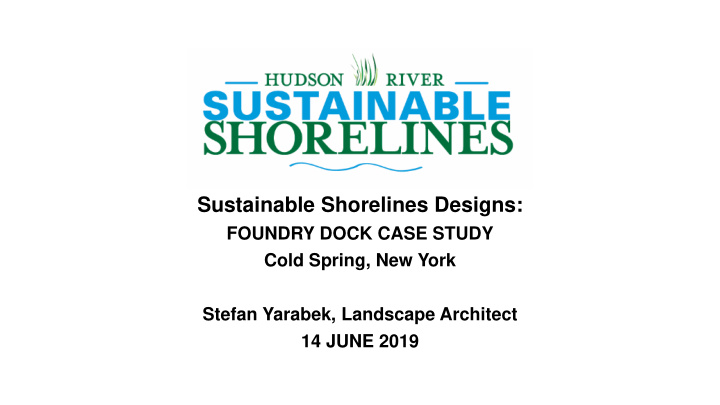



Sustainable Shorelines Designs: FOUNDRY DOCK CASE STUDY Cold Spring, New York Stefan Yarabek, Landscape Architect 14 JUNE 2019
COMMUNITY ENGAGEMENT Scenic Hudson actively engaged the community in the planning process from Brownfield Remediation Public Access to the River Site Use Long Term Management
The new design of Foundry Dock took the space from derelict and underused to inviting and accessible – with seating, terraces, and boat launch.
Clean-up of the site and new plantings reversed the industrial legacy of damage and neglect to the shoreline – allowing a new future for Foundry Dock.
Shoreline stabilization and native plantings have contributed to enhanced shoreline access for passive and active users.
PLAN IMPLEMENTATION & DESIGN Figure 3: A highly exposed area of the site Figure 2: Newly constructed coir rolls where rip-rap was used below the coir at the edge of the shoreline rolls for added protection
Vie iew East of f West Shoreline Steep Slopes In relatively sheltered areas, coir rolls are a soft shoreline option that is sturdy enough to stay in place even after years of heavy ice shear and wave action.
South Vie iew: North Shore Upper Shoreline • Due to tight site constraints of preserving existing trees and being restricted from extending the slope into the river boulder rip rap combined with coir roll/Plug Vegetation was employed • The young plant plugs did not have sufficient time to become established due to frequent seiche • Severe ice and storm seiche from the North eroded the coir rolls
South Vie iew: North Shore Upper Shoreline • Lower Shoreline armored by Boulder Rip Rap left Mid Shore Coir Rolls vulnerable to High Tide Storm scour • Boulder combined with Plug Vegetation of mature plants and root structure will stabilize shore quicker.
South Vie iew: North Shore Upper Shoreline • Due to tight site constraints of preserving existing trees and being restricted from extending the slope into the river boulder rip rap combined with coir roll/Plug Vegetation was employed • The young plant plugs did not have sufficient time to become established due to frequent seiche • Severe ice and storm seiche from the North eroded the coir rolls
North Vie iew: South Shore Mature Trees 2016 North View: South Shore • Preserve Mature Trees in order to minimize disturbance to sub soils – Brownfield • Preserve Mature Trees in order to maintain soil stability • Preserve Mature Trees in order to preserve habitat value and aesthetic enjoyment of park
South Shore Beach Undulating Shoreline • Existing mature trees close to shore require boulder rip rap: • To protect trees • Stabilize shoreline within a limited area
Kayak & Beach Access Tidal Armoring of Beach • Tidal fluctuations are dissipated by moderate sized Boulder armoring along Mean High Tide • Gently sloping gravel ramps provide smoother access at Low Tide
Boulder & Tree Armoring Shoreline Stabilization & Views • Trees provide the strongest structure to the shoreline • Trees need to be strategically placed to preserve views and access • Trees can be pruned strategically to provide views • Pruning increases root strength
River Access Soft Shore • Minimum 3:1 Slopes provide easy Kayak , Fishing and Wading Access • Shoreline and High Tide Boulder Rip Rap securely anchor the beach
Boat La Launch • Timber Trail Bars add stability to the Boat Ramp Beach • The Timber Trail Bars need to extended beyond the ramp into the adjoining earth embankment to avoid wash out
Boat La Launch • Timber Trail Bars degraded at the surface while stabilizing the Boat Ramp
Art rtificial Structure Old Barges • Old Barge and Marine Structures must be tested for toxicity and archaeological importance • Old Barge and Marine Structures are often best left in place particularly at former Brownfields • Serve as habitat enhancements
Marine Structure Barge Timbers weather into Place • Sunken Marine Structures such as Barges are often found beneath Hudson River Shoreline properties • Leaving them in place preserves an evolved ecology • Leaving them in place provides long term stability
Dockside Park: Design-only Case Study
Credit: Milone & MacBroom
Credit: Milone & MacBroom
Credit: Milone & MacBroom
Recommend
More recommend